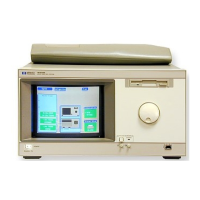Syntax Overview
This overview is intended to give a quick glance at the syntax defined by
IEEE 488.2. It will help you understand many of the things about the syntax
you need to know.
IEEE 488.2 defines the blocks used to build messages which are sent to the
instrument. A whole string of commands can therefore be broken up into
individual components.
Figure 6-1 is an example syntax diagram and figure 6-2 shows a breakdown of
an example program message. There are a few key items to notice:
•
A semicolon separates commands from one another. Each program
message unit serves as a container for one command. The program
message units are separated by a semicolon.
•
A program message is terminated by a <NL> (new line). The recognition
of the program message terminator, or <PMT>, by the parser serves as a
signal for the parser to begin execution of commands. The <PMT> also
affects command tree traversal.
•
Multiple data parameters are separated by a comma.
•
The first data parameter is separated from the header with one or more
spaces.
•
The header SYSTEM:LONGFORM OFF is an example of a compound
header. It places the parser in the machine subsystem until the <NL> is
encountered.
•
A colon preceding the command header returns you to the top of the
command tree.
See Also Chapter 5, "Programming and Documentation Conventions"
Message Communication and System Functions
Syntax Overview
6–7

